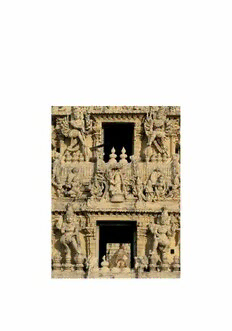Table Of ContentKerstin Schier
The Goddess’s Embrace
Multifaceted Relations
at the Ekamranatha Temple Festival
in Kanchipuram
Ethno-Indology
Heidelberg Studies in South Asian Rituals
General Editor
Axel Michaels
Volume 15
2018
.
Harrassowitz Verlag Wiesbaden
Kerstin Schier
The Goddess’s Embrace
Multifaceted Relations
at the Ekāmranātha Temple Festival
in Kanchipuram
2018
.
Harrassowitz Verlag Wiesbaden
Coverillustration:Thegoddess’sembrace,depictedontheeasternsideofR.s.iGopura,
Ekamranathatemple,Kanchipuram,2009.
BibliografischeInformationderDeutschenNationalbibliothek
DieDeutscheNationalbibliothekverzeichnetdiesePublikationinderDeutschen
Nationalbibliografie;detailliertebibliografischeDatensindimInternet
überhttp://dnb.dnb.deabrufbar.
BibliographicinformationpublishedbytheDeutscheNationalbibliothek
TheDeutscheNationalbibliothekliststhispublicationintheDeutsche
Nationalbibliografie;detailedbibliographicdataareavailableintheinternet
athttp://dnb.dnb.de.
Forfurtherinformationaboutourpublishingprogramconsultour
websitehttp://www.harrassowitz-verlag.de
©OttoHarrassowitzGmbH&Co.KG,Wiesbaden2018
Thiswork,includingallofitsparts,isprotectedbycopyright.
Anyusebeyondthelimitsofcopyrightlawwithoutthepermission
ofthepublisherisforbiddenandsubjecttopenalty.Thisapplies
particularlytoreproductions,translations,microfilmsandstorage
andprocessinginelectronicsystems.
Printedonpermanent/durablepaper.
Printingandbinding:MemmingerMedienCentrumAG
PrintedinGermany
ISSN1860-2053
ISBN978-3-447-11134-8
e-ISBN PDF978-3-447-19807-3
Contents
Acknowledgements...................................................................................................... vii
NotesonTransliterationandTranslation..................................................................... ix
Abbreviations............................................................................................................... x
FiguresandTables....................................................................................................... xi
Introduction....................................................................................................................... 1
1 TheEkāmranāthaTemple........................................................................................... 15
1.1Kanchipuram..................................................................................................... 15
1.2EnteringtheEkāmranāthatemple...................................................................... 17
1.3Ekāmranātha’scentralmyth,divinesymbolsandname................................... 24
1.4NotesonthehistoryoftheEkāmranāthatemple............................................... 29
2 ThemahotsavaattheEkāmranāthaTemple............................................................... 39
2.1HistoricalreferencestothemahotsavaattheEkāmranāthatemple.................. 40
2.2Aghoraśivācārya’sMahotsavavidhi................................................................... 46
2.3RitualstructureofthemahotsavaattheEkāmranāthatemple.......................... 49
2.4Processionalroutes,specialeventsanddonors................................................. 61
2.5Concludingremarks........................................................................................... 71
3 The‘marriagemyth’................................................................................................... 73
3.1Sources.............................................................................................................. 74
3.2Narrativethemes................................................................................................ 93
3.3Concludingremarks........................................................................................... 95
4 RitualsonPaṅkuṉiUttiram........................................................................................ 97
4.1OkkapiranthanKulam–themeetingofthegoddesses..................................... 97
4.2Tapasandtheworshipofthesandliṅga........................................................... 106
4.3Thedivinemarriage........................................................................................... 109
4.4Concludingremarks........................................................................................... 116
vi Contents
5 ThreeGoddesses............................................................................................................ 119
5.1Kāmākṣī,KāmakoṭiandtheKāmakōṭṭam............................................................ 119
5.2KāmākṣīandĀtiKāmākṣīKāḷikāmpāḷ ................................................................ 125
5.3Kāmākṣī,BaṅgāruKāmākṣīandĒlavārkuḻali...................................................... 138
5.4Concludingremarks.............................................................................................. 151
6 PerspectivesonParticipation......................................................................................... 153
6.1Festivalparticipation............................................................................................. 154
6.2Priests ..................................................................................................... 156
6.3The‘SevenStreets’ofOkkapiranthanKulam...................................................... 156
6.4Donorsforthemarriage........................................................................................ 159
6.5Humanmarriages.................................................................................................. 168
6.6Concludingremarks.............................................................................................. 172
7 TheFormationofCulturalMemory............................................................................... 175
7.1Commemoration.................................................................................................... 176
7.2Whatisremembered?–Thetransmissionofculturalmemory............................ 178
7.3Concludingremarks.............................................................................................. 190
Conclusion............................................................................................................................ 191
Appendix............................................................................................................................... 197
Bibliography......................................................................................................................... 201
Acknowledgements
Thisbookisbasedonmydoctoraldissertation,whichIdefendedin2013attheUniversity
of Oslo. The publication was made possible through financial support offered by the
Department of Culture Studies and Oriental Languages (IKOS) and Axel Michaels, editor
oftheEthno-IndologySeries. Ithankthemfortheirgenerousfunding.
This book owes to several people. First and foremost, I wish to thank all the people in
India, who made my field research a positive and fruitful experience, in particular the
priests and participants of the Ekāmranātha temple festival for sharing their thoughts and
knowledgewithme.
My greatest thanks go to my supervisor Ute Hüsken for her genuine interest, prompt
responses, and thoughtful comments. David Shulman deserves special thanks, not only for
generously taking the time to translating the Tamil texts, and supplying me with a copy of
the Ēkāmparanātar Ulā, but also for his inspiring enthusiasm and warm hospitality during
my stay in Jerusalem. I am truly indebted to Harry Falk for teaching me Sanskrit, guiding
methroughmystudies,andforhisgeneroussupportandwonderfultripstoIndia.
For help with fieldwork, I am grateful to my research assistant, Narayanan
Subramanian, for his patience, manifold advice and organization of practical things. Many
thanks for hospitality and warm-heartedness in Kanchipuram go to Nagaswamy Gurukkal,
Anand Gurukkal, K. Balasubramanyam, R. Narayanan, Avinash S. Kumar and Raja; in
Thanjavur to Dr. Sudarshan from the Saraswati Mahal Library and Dr. Kulathooran from
Tamil University; in Pondicherry to Dominic Goodall and Valérie Gillet from the École
française d’Extrême-Orient; in Chennai to Ravi and Ramanadhan Vaidyanaat from the
Agama Academy, and special thanks go to M.D. Muthukumaraswamy, director of the
National Folklore Support Centre (NFSC), and members of his staff, in particular Arun,
DhivyaandSarahfortheirassistanceandagreatfestivaltime.Forhelpwithtranslations,I
am grateful to my Tamil teacher, Dr. S. Arokinathan in Pondicherry, and A.K. Selvadurai
inKanchipuram.
IwouldliketothanktheFacultyofHumanities,UniversityofOslo,forgrantingmethe
doctoral stipend, and the Department of Cultural Studies and Oriental Languages for an
excellentworkingenvironment.IamparticularlygratefultothemembersoftheOsloSouth
AsiaSymposiumfortheirfeedbackandfruitfuldiscussionsovertheyears.
I wish to thank my friends for having a lot of fun, and for their encouragement and
belief in me. I am deeply grateful to my parents for their unlimited love and support
throughoutmylife.Finally,veryspecialthanksgotomyhusbandJanforbeingthere.
Oslo,30.August2018 KerstinSchier
Notes on Transliteration and Translation
Transliteration
Indian words have been transliterated according to standard academic conventions for
Sanskrit. Gods, temples, and historical persons, as well as Sanskrit and Tamil words are
written with diacritics. Personal names of my interviewees, language names, dynasties and
geographical designations like states, towns, rivers, mountains are written in common
transcriptionwithoutdiacriticalmarks.However,whenthegeographicalnamesoccurinthe
sourcetext,Iusediacriticsinthetranslation.Thus,forexample,forthetownKanchipuram
thenamesKanchi,Kāñcī,andKaccimayoccur.
Problematic wastherendering ofnamesgivenin inscriptions.Differentspellingsoccur
andsincesomenamesarenotknowntome,Ireproducethenamesofhistoricalpersonsand
dynastiesasgivenintheAREvolumes,althoughtheyarenotconsistent.
Texts written in Tamil have the Tamil ending –m, such as Periyapurāṇam, whereas
textswritteninSanskritarewithouttheending–m,suchasSkandaPurāṇa.
GenerallyIgivepreferencetotheSanskritspelling,becausemybackgroundisSanskrit.
Moreover, many technical terms are derived from Sanskrit. Thus, for example, I write
Sanskrit abhiṣeka instead of Tamil apiṣēkam. However, if I came to know the word
basicallyinitsTamilizedform,orwhenitwasmostlyusedinthisform,IgiveitsSanskrit
equivalent in parenthesis. For example, I use Tamil tīrttavāri instead of Sanskrit
tīrthasnāna.
Translation
AllinterviewsandconversationsIhadwithintervieweeshavebeeninterpretedfromTamil
bymyresearchassistants.Someofthemhavebeenparaphrased.Further,sometranslations
from Tamil by my research assistant are rather drafted. I have used single quotation marks
for this type of quotes. Double quotation marks refer to accurate quotes from written
sources.
Whenever I quote informants, I have stayed as closely as possible to the translation of
my research assistant. Sometimes, I have added information in brackets to explain terms,
andinsquarebracketsinordertoclarifythenarrativeoftheinterviews.
Abbreviations
ARE–AnnualReportonIndianEpigraphy,NewDelhi.
BṇḍP–BrahmāṇḍaPurāṇa
EI–EpigraphiaIndica,NewDelhi.
HR&CE–HinduReligiousandCharitableEndowmentsDepartment
KāVi–Kāmākṣīvilāsa
KM(Ś)–Kāñcīmāhātmya(Śaiva)
KM(V)–Kāñcīmāhātmya(Vaiṣṇava)
KP–Kāñcippurāṇam
MW – Monier Williams Sanskrit-English Dictionary (http://www.sanskrit-lexicon.uni-
koeln.de/mwquery/)
PP–Periyapurāṇam
SII–SouthIndianInscriptions,Mysore.
SkP–SkandaPurāṇa
Skt.–Sanskrit
Tam.–Tamil
Figures and Tables
All photographs presented here are taken by myself, unless otherwise indicated. All maps
aredrawnbymyselfbasedonGooglemaps.
Figure1.1MapofKanchipuram......................................................................................... 16
Figure1.2MapsectionofEkāmranāthatemple.................................................................. 17
Figure1.3Nine-storiedRājaGopura[1]............................................................................. 19
Figure1.4VāhanaMaṇḍapa[2]withtemporaryerectedthatchedroof.............................. 19
Figure1.5Venuefortheperformanceofthemarriagerituals
left:KampāNadītank,front:maṇḍapaforEkāmranātha[3],behind:1000-pillar
Maṇḍapa[5],right:PalliGopura[6].........................................................................20
Figure1.6Columnedhallwithbalipīṭha[8],flagstaff[9]andshrineforNandin[10].......20
Figure1.7Somāskandamūrtiunderthemangotree...........................................................22
Figure1.8Mangotree(sthalavṛkṣa)[17]........................................................................... 22
Figure1.9ShrineofgoddessPralayakālī[15]....................................................................23
Figure1.10UtsavaSannadhi[16]....................................................................................... 23
Figure1.11Paintingofthepañcabhūtaliṅgasandtheirmyths.......................................... 26
Figure1.12Ṛṣabheśvaraliṅga[12]withUmāsahitapanel ................................................30
Figure1.13Sandstoneshrine,Ekāmranāthatemple...........................................................31
Figure1.14ViewfromtheRājaGopuraonthefourthprākāra,1862–76
Source:MadrasCollegeofArtsandCrafts,GeneralviewfromthetopoftheTemple,
BigConjeeveram,1862-76,accessiblethroughtheDigitalSouthAsiaLibrary
(http://dsal.uchicago.edu/images/madrascollege) .....................................................33
Figure1.15ṚṣiGopura[13],1869
Source:Nicholas&Co.(British,activeMadas,India1860s-1920s),Photo
21823701,ConjivoraminMadras,November8,1869,TheJ.PaulGettyMuseum,
LosAngeles...............................................................................................................35
Figure1.16ColumnedhallattachedtotheṚṣiGopura[13],2009.................................... 35
Figure1.17Naṭarājashrine[21],1897/98
Source:©BritishLibraryBoard.Photo1008/3(322).ArchaeologicalSurveyofIndia,
Subrahmanyaswamishrine,EkambreswaraswamiTemple,Conjeevaram,1897-98.... 36

